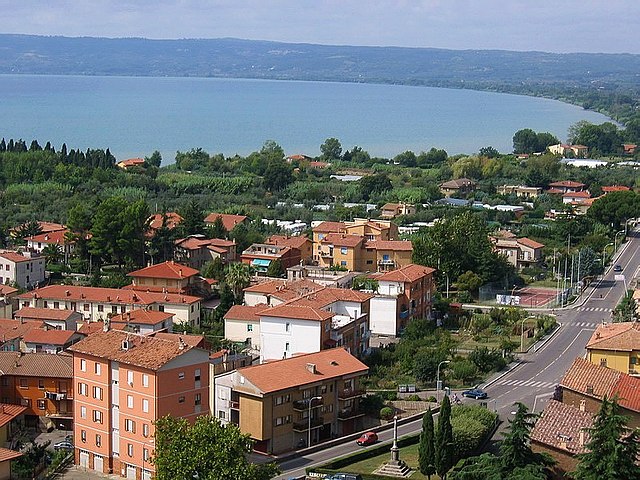Lake Bolsena is a lake of volcanic origin in the northern part of the province of Viterbo called Alto Lazio or Tuscia in central Italy. It is the largest volcanic lake in Europe. Roman historic records indicate activity of the Vulsini volcano occurred as recently as 104 BC; it has been dormant since then. The two islands in the southern part of the lake were formed by underwater eruptions following the collapse that created the depression.
Lake Bolsena
The southernmost end of the lake viewed from the ridge of Montefiascone caldera. Martana is on the left and Bisentino on the right. The straight shore to the far left is Marta. To the left of Martana is the headland of Capodimonte.
The western and northern shores viewed from the eastern shore. The large settlement to the right is Bolsena, at the foot of the northern hills.
The eastern shore viewed from highway SS312 Castrense between Valentano and Latera on the western shore. Center is Bisentina, with Martana to the right and the headland of Capodimonte to the right of it. The city on the left of the far shore is Bolsena
Volsinii or Vulsinii, is the name of two ancient cities of Etruria, one situated on the shore of Lacus Volsiniensis, and the other on the Via Clodia, between Clusium (Chiusi) and Forum Cassii (Vetralla). The latter was Etruscan and was destroyed by the Romans in 264 BC following an attempted revolt by its slaves, while the former was founded by the Romans using the remainder of the Etruscan population rescued from the razed city.
Bolsena at the site of Roman Volsinii. 42°38′41″N 11°59′09″E / 42.64472°N 11.98583°E / 42.64472; 11.98583
Attic red-figure calyx-krater, c. 460–450 BC, from Orvieto (the Niobid Krater).






